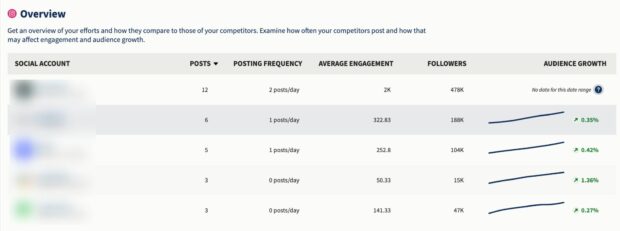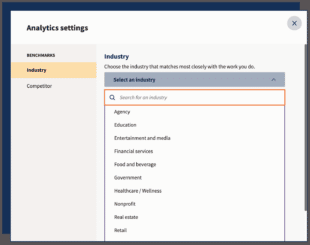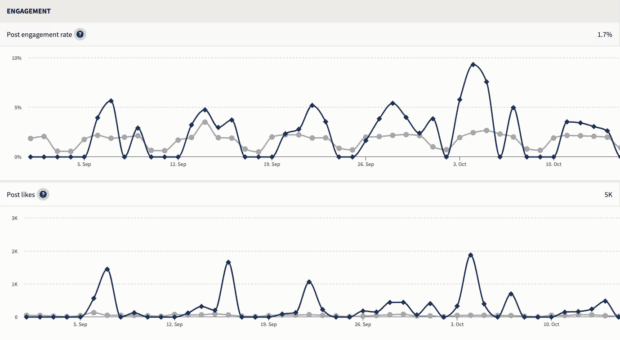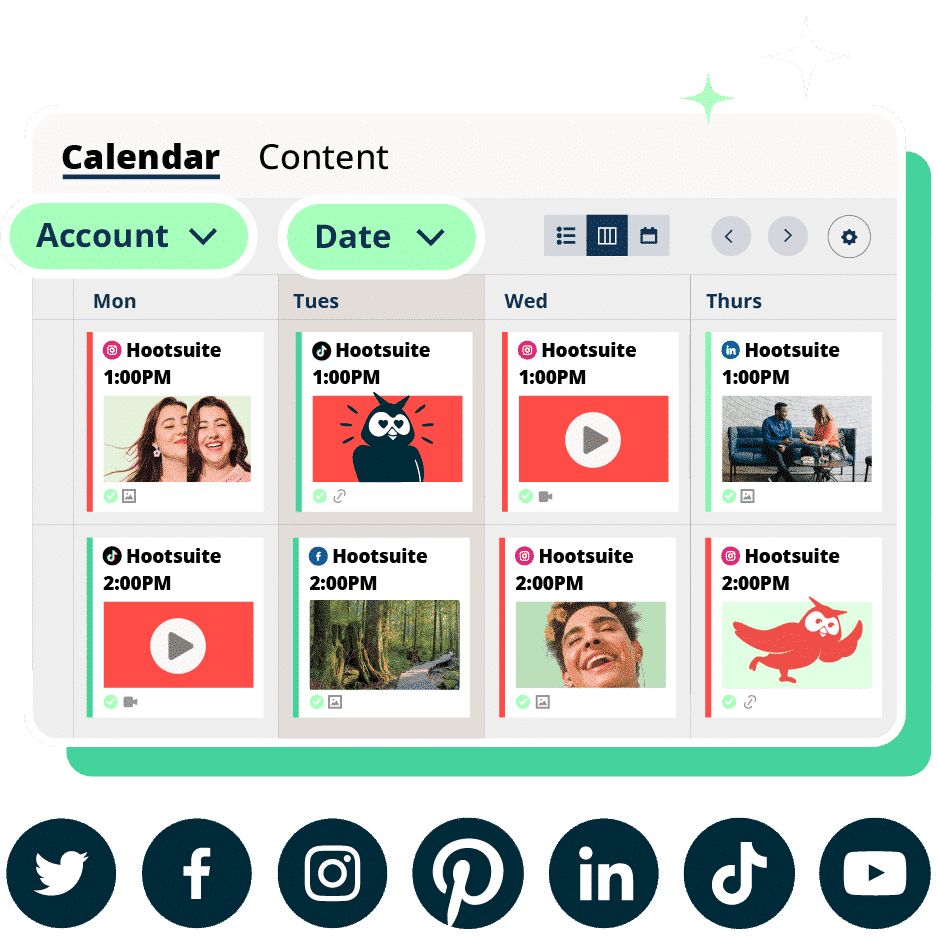Key Takeaways
- Social media audits identify the strengths of your social strategy and highlight areas for improvement.
- When measuring your performance, consider key metrics like engagement rate, post frequency, and audience size.
- Use your audit to confirm that all social profiles align with your brand’s style and guidelines.
- Compare your performance against competitors to identify benchmarks and opportunities.
- Hootsuite’s free social media audit templates can help you run a faster, more efficient audit.
A social media audit compiles and analyzes information about your accounts across all platforms to clearly measure their performance.
Think of your social media audit as a report card: it identifies strengths, areas for improvement, and next steps.
What can a social media audit tell you?
After a thorough social media audit, you’ll have all the information you need to optimize your social media marketing strategy, including:
- Your most effective platforms
- What your target audience wants to see on each network
- Who your audience is (demographics and more)
- What’s helping grow your audience (and what’s not)
- How each platform contributes to your goals
- Which new ideas will help you grow
- Where to focus your attention next
Ready to get started? Use our handy social media audit checklist and make sure you don’t miss a single step.
If you’re ready to get into the audit (or want your own version of this checklist), download the free audit templates below:
Don’t feel like reading? Follow along with our video:

1. Create a list of all your social media accounts
Jot down all your social media accounts to start — everything from the platforms you use daily to the ones you may have neglected. Active or inactive, it’s important to catalog your online presence as part of your social media audit.
In addition to your current social media presence, think about the accounts you don’t have yet. For example, are there any social platforms you haven’t considered? Should you be there?
You don’t need to be active on every network, but an audit is a good opportunity to add new ideas to your future social media strategy.
Where to find this info:
Search each major social network for your brand and product names. Not only might this uncover long-forgotten Facebook groups, but it’s also a chance to catch any imposter or misleading accounts that you can then shut down or report.
Hot tip: Set up a social media monitoring program to watch for any future fakes!
2. Check in on your branding
It’s time to dig a little deeper into each of your social media accounts and make sure they all fit your current brand style guidelines.

Here are the key areas to review for each social account:
- Profile and cover images. Make sure your images reflect your current branding and adhere to each social network’s image size requirements.
- Profile/bio text. Are all fields for your social media bio filled in accurately? Does the copy match your tone and voice guidelines?
- Username. Try to use the same username across all social channels… though having more than one account per network is okay if they serve different purposes. (For example, we have X accounts like @Hootsuite and @Hootsuite_Help.)
- Contact info and links. Does the URL in your profile go to the correct website or landing page? Are your phone number and contact email still right?
- Pinned posts (if applicable). Evaluate your pinned posts to ensure they’re still appropriate and up-to-date.
- Verification. Is your account verified with a blue checkmark badge? If not, should you try? We have guides on how to get verified on Instagram, TikTok, Facebook, and X (formerly Twitter) if you want to pursue this.
Where to find this info:
Visit each of your social profiles and see how your posts look to your followers. Be sure to click on any links to see if they need to be updated.
3. Identify your top-performing social media content
It’s time to audit your social media content.
For each social profile, list your five top-performing posts. Include links to each post so you can easily review them later.
What makes a “top-performing post?” That depends! Try ranking posts by engagement rate to see what your audience likes best.
Depending on your goals for a platform, you may want to focus on a different key metric, like link clicks or conversions.
Look through your top posts for patterns. Then, ask yourself:
- What type of content is getting you the response you want? Photo posts? Videos? Feed, Stories, or Reels?
- What style of content has the highest engagement metrics: Candid, behind-the-scenes content or polished and pro posts?
- Are people responding in the same ways across all networks? Does specific content perform better on one platform than others?
- Do people engage with your posts if you ask a question?
- Are your top posts aligned with your current brand voice? (If not, and they’re performing well, maybe it’s time to re-evaluate that voice.)
Record your thoughts in the notes column of your audit document. (We’ll come back to these notes later!)
Where to find this info:
You can use the built-in analytics tools for each social network to sort and find your top posts for the key metric you’ve chosen.
Not sure how? We have complete guides to using all of them:
- X/Twitter analytics guide
- Facebook analytics guide
- Instagram analytics guide
- TikTok analytics guide
- LinkedIn analytics guide
- Pinterest analytics guide
- Snapchat analytics guide
- Youtube analytics guide
But hold up: That could take forever. Instead, make life easier by using Hootsuite Analytics.
With just a few clicks, you can find the top posts for all your social accounts in one place. You can even schedule regular custom reports sent straight to your email.

4. Evaluate each channel’s performance
Now, it’s time for the actual “audit” part of this whole thing. Get ready to evaluate how each social channel contributes to your overall marketing goals.
If you still need to create a mission statement and a few key goals for each social account, now’s the time!
Several accounts may have similar goals, like driving traffic to your website and increasing conversions. Others may be exclusively for customer service purposes or brand awareness.
For each channel, list out its goal(s) and track your progress toward them.
For measurable goals like traffic or conversions, write down the actual numbers. How many website visits came from Instagram? How many sales came from Facebook Page visitors? If the goal is customer service, write down your CSAT score and see if it’s improving over time. Be specific.
For goals without quantifiable data, record supporting evidence. If your Facebook account is for brand awareness, has your following grown? Have you increased your organic or paid reach?
We want to get clear on the purpose of each of your social channels and measure their effectiveness.

Where to find this info:
Finding relevant information will depend on the goals you set for each channel.
Tracking customer service or brand awareness goals? Try using social listening tools to gather data from real customers. For traffic and conversion goals, try using Google Analytics.
Tracking conversions from social media isn’t an exact science, though it’s easier on some channels than others.
You’ll need to set up Meta Pixel (formerly Facebook Pixel) to track Facebook conversion data, for example, and many networks have their own tracking codes. Many e-commerce platforms also have built-in social channel tracking.
Going platform by platform can be tedious, but you can make your life much easier by using a social media management tool like Hootsuite Analytics for this, too.

You don’t have to take our word for it, either — our own social team uses Hootsuite to conduct their own social media audits.
Running a social media audit through native platforms take an eternity. But running a social media audit in Hootsuite Analytics takes less than an hour.
– Trish Riswick, Social Team Lead at Hootsuite
I have custom reports built for each of our networks and one master report that covers them all. These reports make it so simple and quick to scroll through our content and gain insights into what’s working and not working.
Optional: Go one step further and compare each channel’s performance against your top competitors with social media industry benchmarks.
If you’re a Hootsuite user, we’ve got good news: Hootsuite Analytics makes benchmarking a breeze.
Hootsuite Analytics does Instagram, Facebook, and Twitter competitive analysis for you. You can track up to 20 competitors per network and get a clear view of your strengths and weaknesses — plus actionable insights on the top posts, hashtags, and content formats in your niche.

Competitive analytics in Hootsuite go as far as telling you the average caption length and number of hashtags used per post.

Hootsuite Analytics also features a handy industry benchmarking tool that helps you compare your performance against averages across your industry.
To get social media industry benchmarks, follow these steps:
- Sign in to your Hootsuite dashboard and head to Analytics.
- In the menu on the left side of the screen, scroll to Benchmarking and click Industry.
- Pick an industry that best describes your business.

That’s it! Now you can see how your results compare to average performance stats within your industry. You can set up custom timeframes, switch between networks — Instagram, Facebook, Twitter, LinkedIn, and TikTok — and look up benchmarks for the following metrics:
- Profile impressions
- Profile reach
- Followers
- Audience growth rate
- Engagement rate
- Video plays
- Posting frequency
- Clicks
- Shares
… and more.

You will also find resources to improve your performance right in the summary section:

And, if you need to present your results to your team, boss, or other stakeholders, you can easily download your comparison report as a PDF file.
If you want to conduct an even more thorough competitive analysis, check out this related blog and free template.
Check out this social media competitor analysis guide and free template.
5. Understand your audience on each platform
Next up: we’re going to dig deeper to understand exactly who you’re reaching on each platform.
Audience demographics are a good starting point. For example, Facebook is the most popular platform for men aged 25-34, but YouTube is the place to be for the 18-49 group.
While your audience may differ from the norm, we’ve compiled all the top demographic data for each social network to get you started:
- Facebook demographics
- X/Twitter demographics
- Instagram demographics
- TikTok demographics
- LinkedIn demographics
- Snapchat demographics
- Pinterest demographics
- YouTube demographics
Learn the demographics of your unique audience on each platform and use that, along with the types of posts they prefer, to create buyer personas. (Don’t worry; we’ve got a free buyer persona template to make that easy for you.)
Where to find this info:
You can find demographic information within each platform’s native analytics. It’s a lot faster if you use Hootsuite’s social listening tools, though.
Search for any topic or keyword, then filter by date, demographics, location, and much more. You’ll be able to identify thought leaders or brand advocates, understand your brand’s perception in the market, and get immediate alerts if and when your mentions spike (for good or for bad).
6. Take action: Update your social media marketing strategy
Now that you know where you stand, think about ways to improve your social media metrics. It’s time to revisit the notes you made earlier!
Here are a few questions to ask yourself:
- Which platforms are driving the most results?
- Are there any new social media platforms you should be using?
- Are you neglecting any platforms? Do you even need them, or would it be better to ditch them and focus on your higher-performing ones?
- What content types are working best right now? How can you make more of this?
- Is your content resonating with your expected audience demographics, or has a new potential persona emerged?
Think about new content and campaign ideas, building off what you learned from your top content in step three. For example, if video is a big hit, write down a specific strategy to work more video into your marketing. That could be “Post 3 new Instagram Reels per week” or “Repurpose existing long-form video into short, 15-second clips for social media.”
These decisions don’t have to be forever. Successful marketing depends on testing and experimenting to find what works for your audience.
For each new strategy and idea, write it down in your marketing plan. (Don’t have one yet? We’ve got you covered with yet another awesome template: this free social media marketing plan document.) Your marketing strategy is a living document, so keep it current.
Where to find this info:
Your brain and this audit! Use all the data you’ve collected so far to generate new ideas. Have your goals for each platform in front of you so that you can connect your updated marketing plan to them. Remember to let others know when you’ve updated the marketing plan, so everyone is on the same page.
Once you’re done with your audit, plan the next one! Stick to a regular schedule. Quarterly works well for most companies, although you may want to check in monthly if you run many campaigns or channels.
Regular audits connect your team’s day-to-day marketing work with your company goals. Over time, you’ll refine your social strategy and learn how to best connect with your audience.
1. Hootsuite
Okay, we’re biased, but seriously: Hootsuite will be your number-one helper for this social media audit.
Hootsuite provides tons of fascinating, customizable data through our Analytics tool (think growth, engagement, demographics and more!).

It’s also a great tool for setting up social listening, investigating brand sentiment and mentions and benchmarking competitors.
Seriously, give it a whirl… we’ve got a free trial for you right here.
2. Google Analytics
Sure, Google Analytics is technically for website analysis, but you may find it helpful for tracking the effectiveness of social campaigns and funnels.

Use this platform to see just how successful your social accounts are at driving traffic, especially if that’s one of your overall marketing goals.
3. Talkwalker
We love Talkwalker so much that we’ve integrated it into our social listening tool, but you can use the platform alone, too.

The tool helps you monitor brand mentions across all types of social media channels (including emerging channels, like Bluesky) and much more. Talkwalker can even provide real-time insights like sentiment analysis, trending content, and much more.
4. Later
Later is great for business owners who run their own social media and like to visualize and preview social media content before they post.
Beyond content planning, Later can also help with your social media audit by providing insights into the performance of your posts and help optimize posting times.

However, keep in mind that the platform does lack some more advanced analytics features like competitive analysis and industry benchmarking.
5. Buffer
Buffer’s analytics feature makes it a valuable tool for social media audits, with insights into audience engagement, performance tracking, and demographics.

Its user-friendly dashboard is simple and straightforward, but it doesn’t come with social listening features or competitive benchmarking.
Save time by managing all your accounts in one place with Hootsuite. Plan content and campaigns, schedule posts, manage conversations, and see all your analytics and ROI data with quick, automated reports. Power up your social marketing today.








